|
Mahabalipuram is one of the popular tourist destinations of Tamilnadu. The ancient rock shore temples and other structures
constructed by the Pallavas provides a wonderful experience to the
tourists. These monuments at Mahabalipuram are excellent examples of
Pallavan and Dravidian architecture.
Mahabalipuram is also known as "Mamallapuram"
after the Pallava King Mamalla. There are many cave temples,
chariots (Rathas), sculpted reliefs and structural temples.
Some of the most important structures of
Mahabalipuram are the Pancha Rathas (Five Rathas), Arjuna's Penance,
Varaha Mandapam, Ramanuja Mandapam, Shore Temple, Krishna Mandapam,
Mahishasura Mardini Mandapam, old traditional light house and a
conventional light house among many other rock structures.
The area of these rock structures and temples
lie very near to the Bay of Bengal.
View
Mahabalipuram Photo Gallery
Pancha Rathas:
The five Rathas (Pancha Rathas) are five
monolithic pyramidal structures named after the five Pandavas and
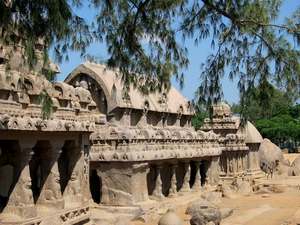 their
wife Draupadi. The five rathas are
Draupadi’s Ratha, Arjuna’s Rath, Nakul – Sahadev’s Rath, Bhima Rath
and Dharamraja Yudhistar’s Rath. These
are very beautiful structures. their
wife Draupadi. The five rathas are
Draupadi’s Ratha, Arjuna’s Rath, Nakul – Sahadev’s Rath, Bhima Rath
and Dharamraja Yudhistar’s Rath. These
are very beautiful structures.
Draupadi's Rath is a simple structure in the
shape of a hut, stands at the entrance gate. This rath is dedicated
Goddess Durga. Next chariot is Arjuna's Rath dedicated to Lord Siva.
Nakul-Sahadev Rath is in front of the Arjuna's rath. This is
a double decored building, dedicated to Lord Indra – the God of
Rain. Bhima's rath faces west and it
measures 42 ft in length, 24ft in width and 25ft in height.
Dharmaraja rath is named after the eldest Pandava brother Dharmaraja
Yuddhishtira. This rath is the largest one among the Rathas.
Arjuna's Penance:
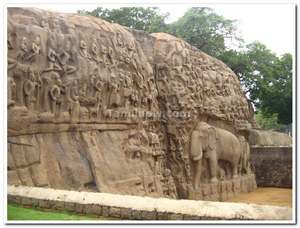
This is a marvelous art structure at
Mahabalipuram. This is a rock bas-relief was built by king
Narasimha I. It measures 27 meters in
length and 9 meters in height with a crack in the middle of the rock.
Arjuna, the great hero of the Mahabharatha, performs various
austerities to please Lord Siva. There is also a belief that these
sculptors shows the meditation, Bhagiratha (an ancestor of Lord Rama)
performs to bring the heavenly river Ganga down to earth. Whatever
the story is, the architectural skill of the craftsmen of Pallava
dynasty is worth appreciating. Arjuna’s penance is really a
wonderful portrayal of art.
Mandapams:
There are many mandapams in Mahabalipuram. Some
of the important ones are Krishna Mantapa,
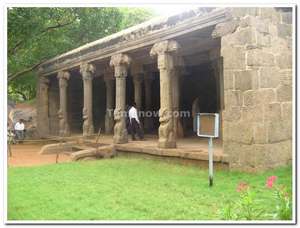 Mahishasuramardini
Mantapa, and Varaha Matapa. Krishna Mandapam is the biggest among
the Mandapams and it lies next to the Arjuna's Penance. The
sculptures inside this Mandapam beautifully picturize the myth of
Lord Krishna during his brave and energetic adulthood. Mahishasuramardini
Mantapa, and Varaha Matapa. Krishna Mandapam is the biggest among
the Mandapams and it lies next to the Arjuna's Penance. The
sculptures inside this Mandapam beautifully picturize the myth of
Lord Krishna during his brave and energetic adulthood.
Mahishasura Mardini Mandapam is a rock cut
temple. It consists of three small shrives in the inner wall
which is exactly the typical pattern of the pallava art and
architecture.
Varaha Mandapam is lies besides the
Arjuna penance. There are four striking
bas-reliefs, the northern one with Lord Vishnu (Varaha) Varaha (the
mighty boar) standing at one feet on top of Naga, the snake king. He
is rescuing Prithvi, the goddess earth from the primordial ocean.
The Ramanuja Mandapam is one of the well
finished Mandapams of Mahabalipuram. It was earlier dedicated
to Lord Shiva. The Vaishnavites who wanted to
build a Vishnu Temple destroyed this beautiful structure.
Many of the structures in Mahabalipuram are not
finished completely like the Rathas, Rayar Gopuram etc. The cause of
this breakup is not known.
Shore Temple:
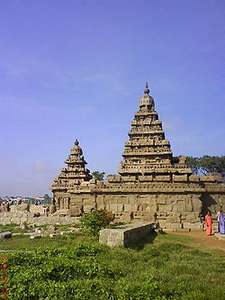 It
is believed that there were seven shore temples known as "Seven
Pagodas" at Mahabalipuram in ancient times. Legend has the
existing rock temple had six other temples once stood with it. It
has been classified as a "UNESCO World Heritage Site". It
is believed that there were seven shore temples known as "Seven
Pagodas" at Mahabalipuram in ancient times. Legend has the
existing rock temple had six other temples once stood with it. It
has been classified as a "UNESCO World Heritage Site".
The six missing temples have continued to fascinate locals,
archaeologists, and lovers of myth alike, and have recently returned
to the archaeological spotlight after the December 2004 Tsunami that
hit Mahabalipuram too. The ocean water off Mahabalipuram’s coast
pulled back approximately 500 meters. Tourists and residents who
witnessed this event from the beach recalled seeing a long, straight
row of large rocks emerge from the water.
Archaeological Survey of India (ASI) and the Indian Navy began
searching the waters off the coast of Mahabalipuram in 2005. They
discovered the remains of two other submerged temples and one cave
temple within 500 meters of the shore. Although these findings do
not necessarily correspond to the seven pagodas of myth, they do
indicate that a large complex of temples was located in
Mahabalipuram.
Krishna's Butter Rock:
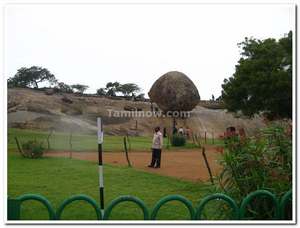 There
is a huge rock standing on one of the hills of Mamallapuram which is
named as Krishna's Butter Rock. This rock stands on one side of the
hill and looks as if it will roll down. Fearing any such accident,
the Government once tried to pull down the rock with the help of
elephants. But it did not even budge. There
is a huge rock standing on one of the hills of Mamallapuram which is
named as Krishna's Butter Rock. This rock stands on one side of the
hill and looks as if it will roll down. Fearing any such accident,
the Government once tried to pull down the rock with the help of
elephants. But it did not even budge.
Mahabalipuram is still to be discovered. There are mysteries still
to be uncovered. Whatever it is, Mahabalipuram is a marvelous
example Dravidian and Pallava architectural skills.
|